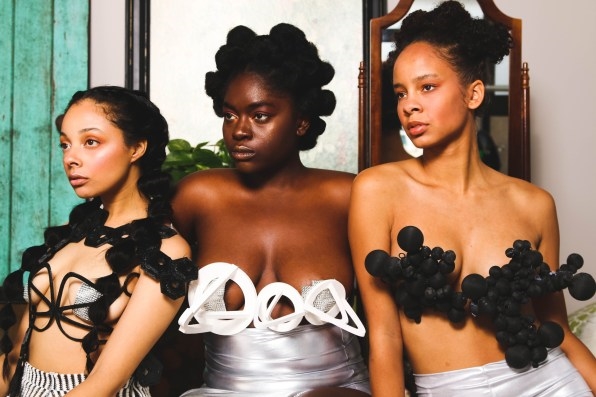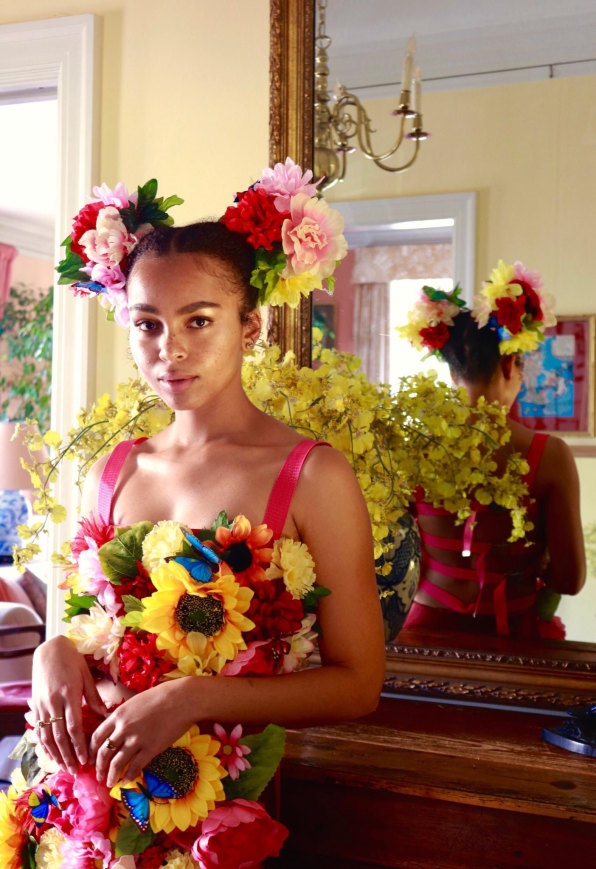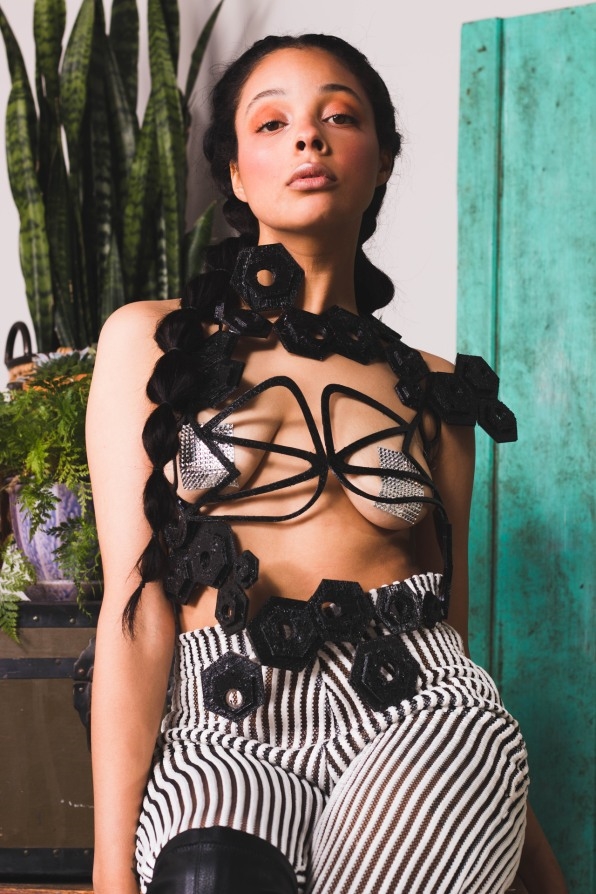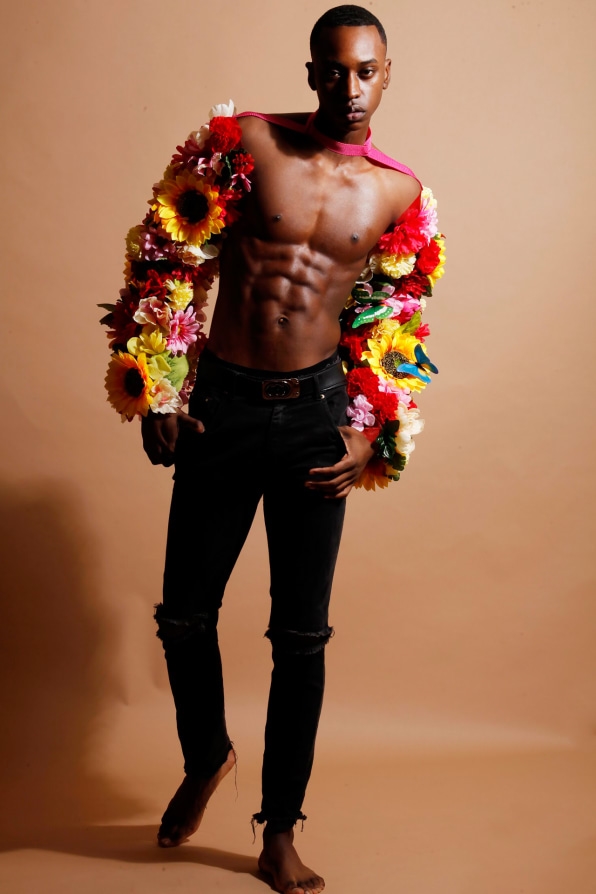It didn’t dawn on 18-year-old Shami Oshun that she was preternaturally talented at designing clothing until last year. She needed a dress for prom and was running out of time, so she whipped together a glorious purple gown trimmed with large fabric flowers in one day–all using $15 worth of tulle fabric.
She shared a picture of it on Twitter and it went viral. Essence, Teen Vogue, and dozens of other websites featured it. She was on the nightly news. Everybody was in awe of her creation.
Oshun had been quietly working on sewing and design throughout high school. It had been a way for her to cope with some of the harder parts of teenage life, like bullying and the death of her grandfather. But she didn’t seriously consider making it a real business until the prom dress incident.
Perhaps she would have taken fashion design more seriously if there had been more people that looked like her in the industry. When I chatted with her, she said that it was hard to picture a life in fashion–or even a pathway to breaking into the industry–when so few black people were represented in it. Without clear role models, Oshun has had to forge her own path. Here is how she’s doing it.

hami Oshun, far right. [Photo: courtesy of Shami Oshun]
Fast Company: Tell me about your brand.
Shami Oshun: My brand, Shami Oshun, is a high-fashion, ready-to-wear brand based in California that brings color to the world. My name, Shami, means light of the sun, and Oshun refers to the goddess of water and love. The spirit of these words are incorporated into every design and sewn into every piece.
FC: What made you decide to launch it?
SO: The brand was actually born out of a place of sadness. When I was a sophomore in high school, I went through a phase when I was being bullied. I was very involved with volleyball, and then because of a disagreement with a friend, I was suddenly pushed out of that friend group.
Then on top of all of that, I experienced some tragedy. One of my friends passed away. And my grandfather died. All of this made me depressed. I spent a lot of time at home instead of attending school.
Then, one day, my dad came back from a trip. He brought me this beautiful fabric and I was inspired. I created several pieces of clothing and sewed them myself. I posted my designs on Instagram and got a lot of positive feedback. Something else that happened was that I created my own prom dress and managed to put it together in one day, using $15 worth of tulle. I shared it on social media and it went viral, with websites like Essence, Teen Vogue, and Buzzfeed writing about it. Because of all of this, I decided to launch a brand.
In my most recent collection, you’ll notice that there is plenty of color, and that I use flower motifs. These days, when I design, I am trying to capture the happier parts of my childhood. In the photo shoots I did for these pieces, I went back to places from when I was younger that are tied to happy memories. So even though the brand started in a sad place, it is now tied to optimism and positivity.

FC: Are black entrepreneurs underrepresented in your industry? Why do you think this is?
SO: As a young black woman who is trying to make a name for myself in the fashion industry, it’s very hard when I don’t see very many successful designers out there who look like me. It’s also hard for me to to tell my friends and family what I am doing by pointing to a more established designer and saying, “I want to be just like this person.” Because so many of these designers come from very different backgrounds than mine, so it just seems like such a long shot that I can achieve what they have achieved.
And without other people from my community connected to the fashion industry in some way, it can be hard to figure out how to break in. I didn’t know where to find resources out there, so I sort of had to figure it out on my own. I wanted to 3D print my clothes, so I went to my local community college to see if I could figure out how to do it. Fortunately we’re a pretty good community here, so the college let me use their machines for free, and that’s how I got started.
FC: Do you feel like black consumers are underserved in your product category? If so, then why and how?
SO: Recently, I’ve noticed more companies using black models in their ad campaigns. But when you look back at their website, most of the models are still white. So as a black woman, I still do not see myself in many brands.
And there’s not only a problem with a lack of representation, but also misrepresentation. We still see brands making racist T-shirts, like the time H&M created a hoodie with the words, “coolest monkey in the jungle” printed on it, with a black boy as the model.

FC: Have you faced any obstacles as a person of color trying to launch a business? What are they? How did you overcome them?
SO: For me, it’s a combination of being young and also being a person of color that I think results in me not being taken more seriously. I’ve found that once people see my work and my work ethic, I’m taken more seriously.
I was in a business competition not long ago, and the main reason that I lost was because of a lack of diversity on my website. I couldn’t understand it because I had a had plenty of black and Latina models. But then I realized that what they were saying is that I didn’t have any white models.
I didn’t let this affect me. And I’ll take this as a sign that I need to keep having a wide diversity of models on my site.

FC: Have you deliberately tried to be a visible face of your brand?
SO: Not deliberately. I originally wanted my brand to stand for itself, even though it bears my name. But after my prom dress went viral, I got a lot of messages from young girls of color who wanted to be fashion designers and said that I inspired them. They said they felt that they too could start a brand because they saw me doing it. Then I realized it was important to be the face of the brand so that other young women see a young designer that looks like them.
FC: What is your advice to other black people who are passionate about fashion/apparel and want to make an impact in this industry?
SO: First, be proud of your art and who you are. Second, create your own support group.
This interview has been condensed and edited for clarity.
Fast Company , Read Full Story
(55)